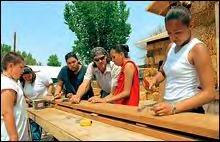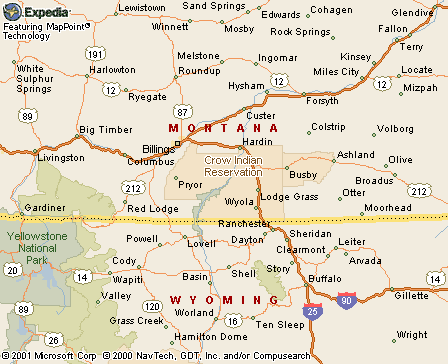|
|
Canku Ota |
|
|
(Many Paths) |
||
|
An Online Newsletter Celebrating Native America |
||
|
August 24, 2002 - Issue 68 |
||
|
|
||
|
Crow Girls' Winning Science Project is Not the Last Straw |
||
|
by Michelle Nijhuis | Special to
The Christian Science Monitor
|
||
|
credits: Photo by
Cheryl Humbert
|
|
In English and the Crow language, one speaker
after another calls them symbols of hope for the Crow tribe. "We
have just met the next generation of tribal leaders," says Crow
chairman Clifford Birdinground Jr. This summer, a crew of volunteers raised the building, and its metal roof now gleams near the edge of the park, inspiring renewed interest in straw-bale building as a solution to the chronic housing shortages here. For the 11,000 members of the Crow tribe, such tangible accomplishments are rare. The tribal government is shadowed by chaos and scandal; unemployment on the southeastern Montana reservation ranges from 60 to 80 percent; and the county is consistently among the 20 poorest in the nation. The girls – Lucretia Birdinground, Kimberly Deputee, Omney Sees The Ground, and Brenett Stewart – "were getting a lot of flak from their peers at first," their teacher, Jack Joyce, tells the crowd in the park. "The boys in their class said, 'Why are you working so hard? You're not gonna win anything.' Well, you might say those boys are now eating crow." Two years ago, when the girls entered the eighth grade at Pretty Eagle Catholic School, Mr. Joyce told them about the Bayer/National Science Foundation competition for middle schoolers. Each entry had to use science to address a problem in the community. The girls chose one they were all too familiar with: the lack of quality housing. On the Crow reservation, as on many others, multiple families often crowd into trailers or cheaply built government housing. The drafty houses are expensive to heat, and several people have frozen to death in recent years during the frigid Great Plains winters. Joyce suggested the girls visit a local resident who lived in a house built with straw bales. "When he told us about straw-bale houses, we kind of looked at him like he was crazy," Lucretia remembers. "It wasn't until we saw that house, and saw how pretty and nice it was, that we knew he was telling the truth." When the girls talked to other tribe members about the advantages of straw-bale houses, they met a lot of doubts and questions. So they designed some experiments to show that the stucco-covered walls are waterproof, fire-resistant, and a good form of insulation. When their entry made it to the competition's top 10, the girls and Joyce were flown to Disney World for the final results. They captured the grand prize: a $25,000 Christopher Columbus Fellowship Foundation grant to help them construct a straw-bale building. Oprah Winfrey then flew the girls to Chicago to appear on her show. She gave them another $25,000 grant, plus $20,000 worth of Stanley tools. The next step was to talk to the Seattle-based Red Feather Development Group, which had built the first straw-bale house on the Crow reservation. The nonprofit group uses volunteer labor, and its staff were eager to begin another project in Crow country. The girls decided on a community study hall as a project that would not only demonstrate the advantages of straw-bale building, but also benefit tribal members directly. An architect from Red Feather designed the structure, and 35 volunteer builders arrived on the reservation in mid-July. They worked in temperatures near 120 degrees to finish the 900-square-foot building in just 2-1/2 weeks. The girls worked at the site nearly every day, but many of their neighbors were hesitant. "It's a great project. I just wish there were more of our people out there," says tribal legislator Jared Stewart. "People are so afraid to try new things." That reluctance may be fading. Dozens of tribe members toured the new study hall at its official opening, and more than a few asked how they could secure a loan for a straw-bale house of their own. The Red Feather Development Group has made a three-year commitment to housing projects on the Crow reservation, and Executive Director Robert Young is talking with the tribe about establishing an independent development office in Crow Agency. SchoolKiT.com donated computers and software to the study hall, and Rena Frank, the tribe's director of human services, hopes everyone "from three-year-olds to senior citizens" will find a use for the space. Ideas include individual tutoring, traditional storytelling, and recording oral histories. The girls are finished with construction work for now, but they may begin other projects soon. Lucretia dreams of building a straw-bale house for her family, and Kimberly plans to become a professional builder. "I can't believe this [study hall] is real," Kimberly says. "For so long, we just had it written down on paper. We had no idea it was going to come to life."
|
||||
|
|
||
|
|
||
| Canku Ota is a free Newsletter celebrating Native America, its traditions and accomplishments . We do not provide subscriber or visitor names to anyone. Some articles presented in Canku Ota may contain copyright material. We have received appropriate permissions for republishing any articles. Material appearing here is distributed without profit or monetary gain to those who have expressed an interest. This is in accordance with Title 17 U.S.C. section 107. | ||
|
Canku Ota is a copyright © 2000, 2001, 2002 of Vicki Lockard and Paul Barry. |
||
 |
 |
|
|
The "Canku Ota - A Newsletter Celebrating Native America" web site and its design is the |
||
|
Copyright © 1999, 2000, 2001, 2002 of Paul C. Barry. |
||
|
All Rights Reserved. |
||
 CROW
AGENCY, MT – On a blistering morning in late July, four young girls
sit on a stage in the town park, smiling and sweltering in heavy dresses
trimmed with elk teeth.
CROW
AGENCY, MT – On a blistering morning in late July, four young girls
sit on a stage in the town park, smiling and sweltering in heavy dresses
trimmed with elk teeth. 